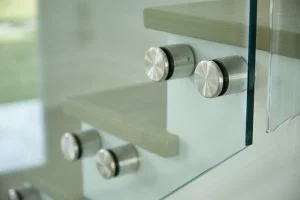What is Glass fencing?
Glass fencing, or glass railing, is the new, modern solution for railing. It is becoming increasingly popular both for aesthetic and functional purposes. Hands down, glass railing provides some of the best looking railing systems on the market.
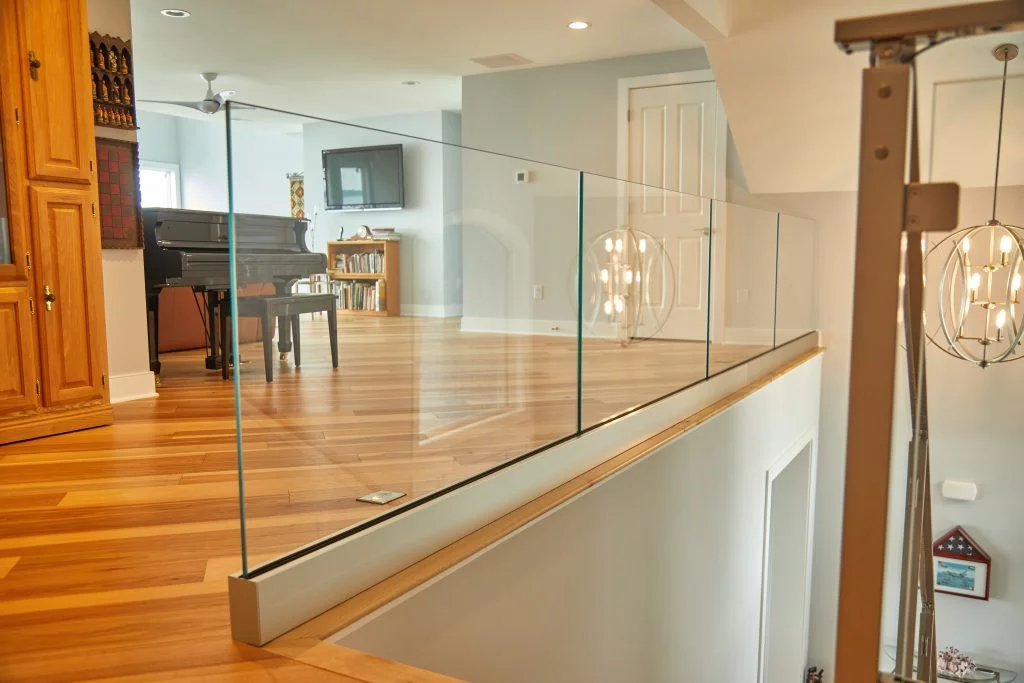
Table Of Contents
Glass Railing Pros & cons?
Pros:
Glass Strength:
Despite its reputation, glass fencing is the strongest railing infill in the modern railing industry.
Tempered glass is extremely durable and actually helps strengthen the railing supports as well. There is a reason glass railing is used in so many commercial applications.
Ease of Installation:
Most people assume that glass would be harder to install than a traditional railing. However, since Viewrail glass panels are custom made to fit your project, there is very little difficulty involved.
In fact, since you are installing 4’ sections at a time with easy-to-use hardware, it usually moves faster than installing a cable railing system.
As Open Views As Possible:
There is no greater railing for your view than glass railing. It is the only railing system where you can see completely through the infill.
Many of the best looking completed project pictures we receive use glass railing.
Great Customization:
An amazing perk to ordering a glass railing project is the amount of customization you receive. Viewrail completely engineers and manufactures the glass to custom fit your project.
This allows you to overcome obstacles that otherwise would be “worked around.”
Cons:
System Cost:
It’s no secret that glass is, on average, a higher investment than other modern railing systems. However, there are options available that can be fairly competitive with a cable railing system.
One thing to consider when looking at the cost is the reduced installation time and associated costs, as well as the extreme longevity of glass fencing.
Cleaning:
The concept of cleaning glass railing is something that most people worry about, and to some extent, as with anything, some cleaning maintenance is needed. However, it’s not difficult or very time consuming.
Everyone knows how to clean a window or mirror and the process is simple. The stigma that glass railing will just magically accumulate a palpable layer of “besmirches” is not true. The reality is, you should only have to clean a glass railing as often as you are having to clean a sliding glass door or your window panes.
General Misinformation about Glass:
This one would be a pseudo-con as it is a lack of understanding, rather than a reality. Glass railing is an enigma to many customers. There’s an air of mystery and a sense of caution when most people think of glass fencing as an easy-to-install safety structure. But, glass railing has been used for railing purposes for decades and is often the railing of choice for high traffic, commercial projects.
The amount of strength that a tempered glass panel provides out performs any other modern railing option. And, with Viewrail’s customization, you receive easy to handle, labeled panels that make installation a breeze.
What types of glass fence railing systems are there?
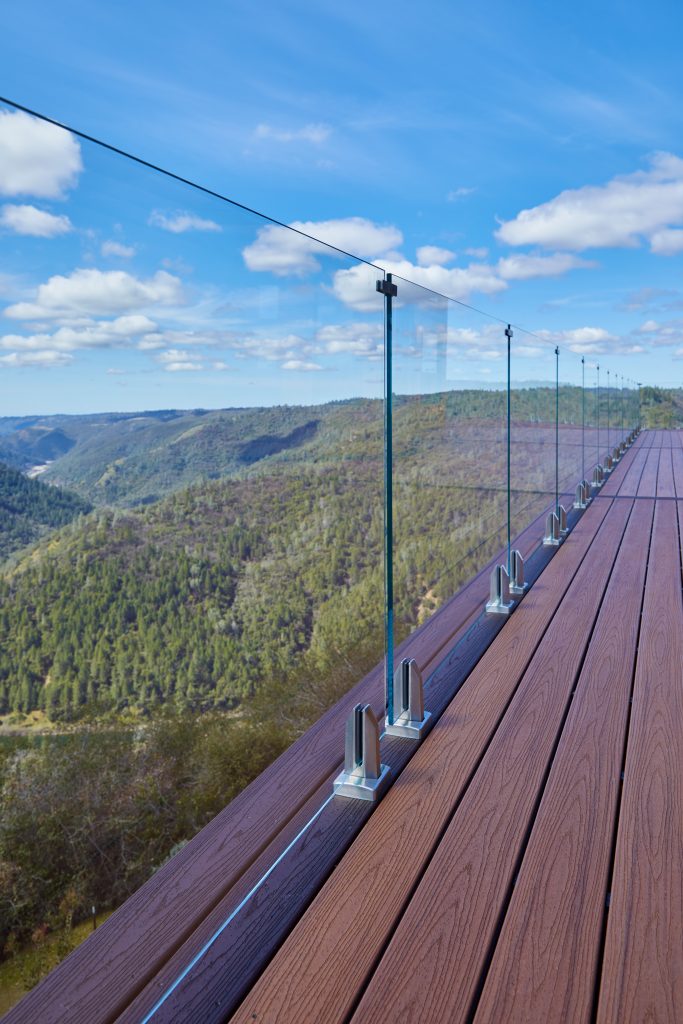
Glass fence railing has the widest range of product offering. There are multiple unique mounting styles, but typically these are categorized as “Framed” or “Frameless Systems.”Framed systems are what most people think of when they visualize glass railing. This is a glass panel set between posts.
Because the majority of the railing industry uses posts, this is easily the most popular system.
Frameless Systems usually have minimal hardware towards the bottom of the panel. The goal for these systems is to have as clean a view as possible. Below is a breakdown of the different options available in each system. (Want to learn about all types of glass?)
Framed Systems:
Post to Post Glass
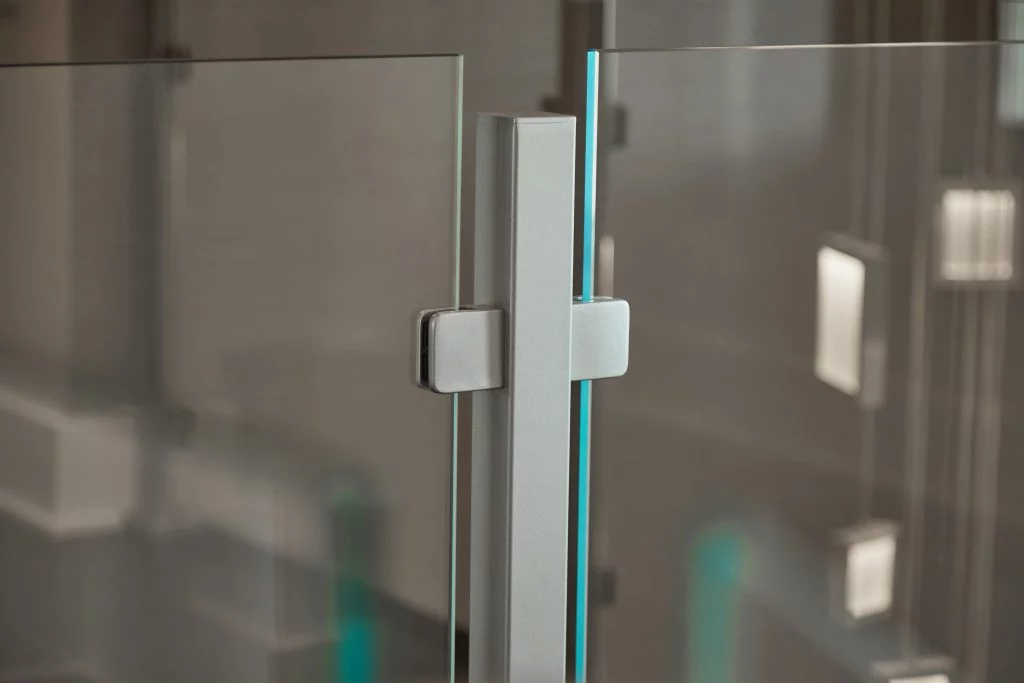
The posts and handrail provide our strongest glass railing system overall. This is the only glass system that mounts the glass in between vertical uprights and also allows a handrail to sit on top of the posts themselves. This system is perfect for any type of application.
Barrier Glass
Barrier glass uses panels between posts, but with no handrail, and the glass sits slightly higher than the post itself. There are multiple different types of post finishes and mounting styles available. Barrier glass is a great solution for any level area and is typically found on balconies and decks.
Because each post is independent of each other, it is especially important to make sure these posts have great blocking. With no handrail on top, this system installs faster than a normal post to post system and has a cleaner view over the top.
Frameless Systems:
Base Rail
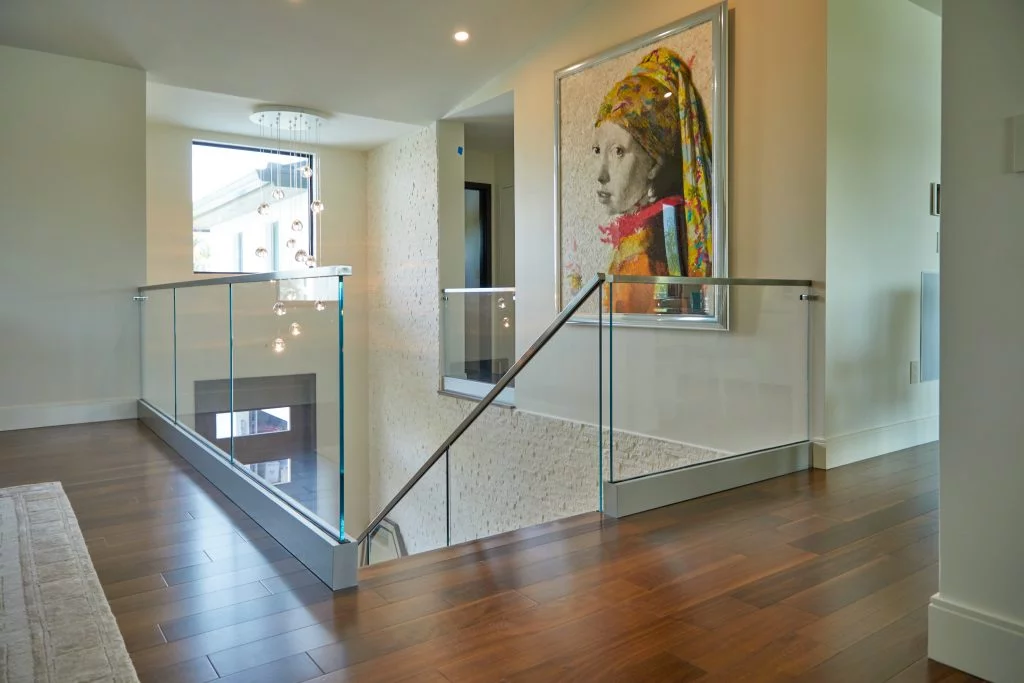
These can be used in any environment: residential or commercial, coast or non-coastal. They will work on stairs with an angled wall or level runs. The main thing to consider is if you need significant draining or not.
Base Rail is one of the strongest frameless system as it is provides a consistent structure the full length of the run. It is often used in commercial and coastal settings. The joining pins every 4’6″ between Base Rail pieces allow drainage on any deck surface.
Surface Glass Fence Talons
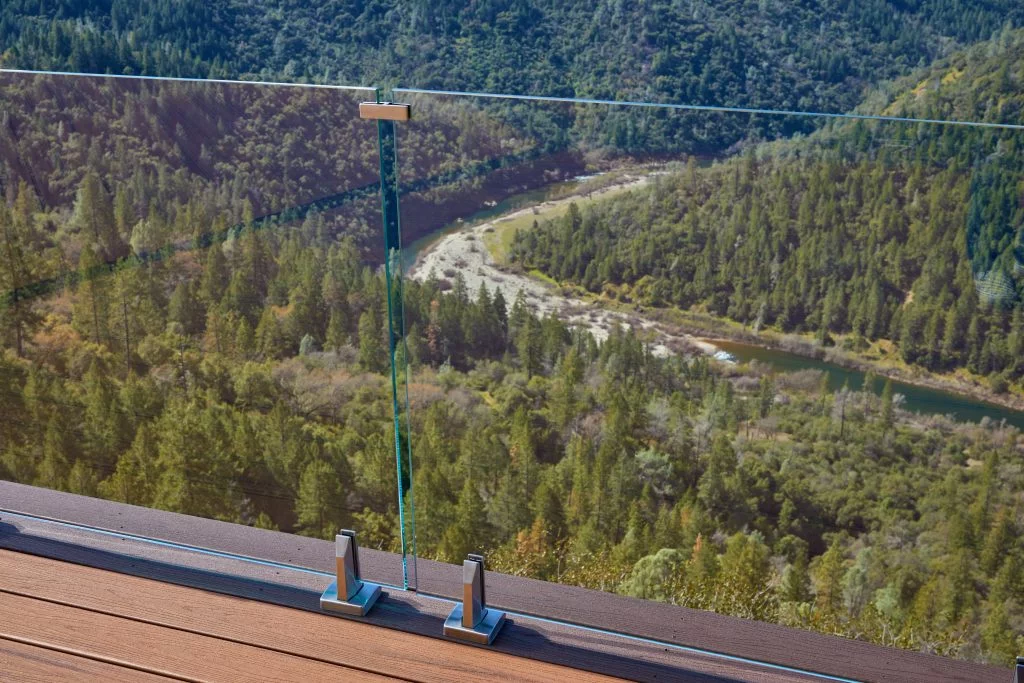
One of the more popular glass systems, this is the lowest profile surface mounted glass railing. The surface talons are quick and easy to install, and provide a very clean line of sight. Constructed from a flash anodized Aluminum and then powder coated, talons can be used in both extreme coastal conditions or simple interior applications. They are able to be used in any level run, whether that be on a wood or cement surface.
However, due to the height of the Surface Talon, they are not great choices for mounting on stair treads. Most often you will see these on balconies, decks, or pool barriers.
The Talon System is one of the easiest to install. There are two talons per panel and once the talons are mounted, the glass can be put into place quickly. Tightening the glass is made easy with the simple socket head.
Ascend Talons
The Ascend Talon Railing is one of our most versatile glass railing systems. Available in 2205 Steel or a powder coat finish on Aluminum, it works in both coastal and interior environments. Since the Ascend Talon is taller than the Surface Talon, these can work on both angled or level surfaces.
The fastening mechanism attaches through holes in the glass and provides extremely high strength results. This is a frameless glass system with great support as it is constructed from the same 2” x 2” body as our full post system. The 14” supports give you the comforting feeling of robust attachment points without sacrificing your view.
Stand Off Pins
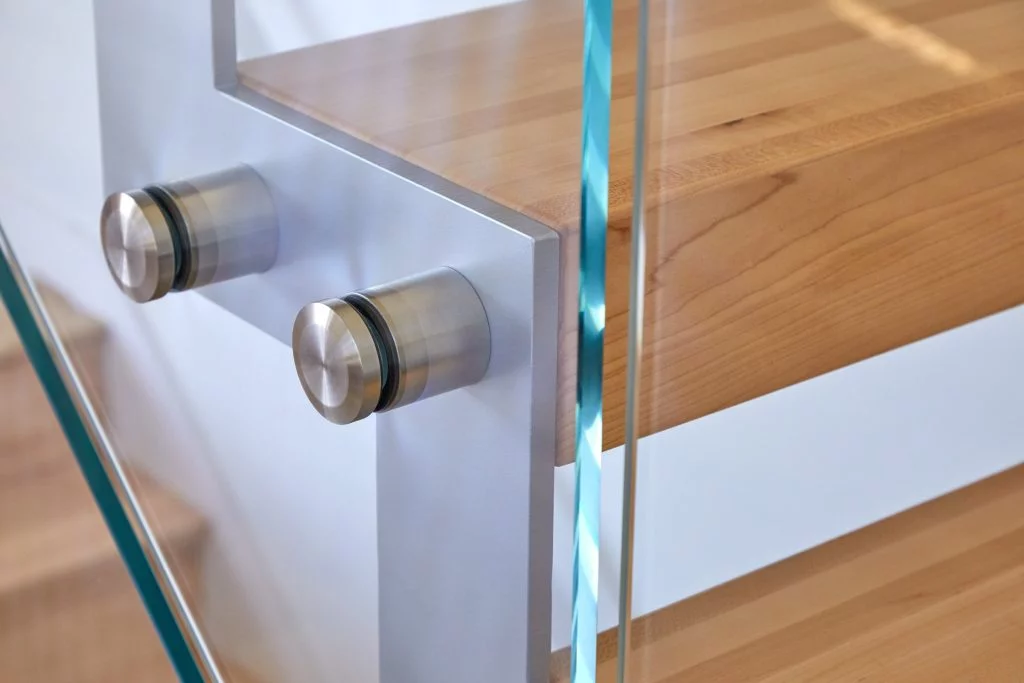
Stand Off Pins is our most popular fascia mounted frameless glass system. With at least four per panel, it is extremely strong. The installation is a bit more involved than our other systems, but the end result is unparalleled. Constructed from a flash anodized Aluminum and then powder coated, these can be used in any environment. Viewrail’s Universal Standoff Pins can be used in any setting from a stair to a deck, and the FLIGHT pins are used to fit perfectly in pre-drilled FLIGHT treads for an easy installation.
They are recommended for wood surfaces, and are often found in both residential or commercial applications. Due to their adjustability, they work well for both level and angled runs of railing. It is important to have access to the fascia board while installing, as the tightening process is done through the front face of the Stand Off Pin.
Indoor vs Outdoor Glass Fence Railing
One of the excellent things about glass railing is it performs perfectly both indoors and outdoors. Any of the glass railing systems covered above can be used for indoor glass railing or outdoor glass fencing. When it comes to an interior project, there is not much to consider besides what aesthetic you want and which system you would like to install. However, when planning for an exterior project there are a few things to take into consideration.
Material and Finish: For any exterior project you want to have the correct material and finish to stand up to the type of weather you receive. You can choose between Aluminum, 2205 Stainless Steel and 304 Stainless Steel. There is also a series of powder coat options available. You can see a more in depth analysis of which type of material best suits your project here . However, the general rule of thumb is if the project is located within 5 miles of the coast, receives acid rain, or is exposed to extreme UV rays, then brushed 2205 Stainless Steel or Aluminum with a Fluoropolymer finish is needed.
Glass Type: There are two main types of glass panels used in exterior glass fencing: Tempered or Laminated Tempered. Tempered glass is what most residential projects use and is an extremely durable ½” solid panel. Laminated glass is two thinner tempered panels with a laminated inner layer. For exterior projects, an SGP lamination is recommended. This type of lamination withstands UV deterioration, moisture, and is even rated for hurricane force winds.
Drainage: Since glass fencing is a solid barrier, drainage and debris build up should be taken into account. In an area where leaves or other debris would need to be swept off a deck or balcony, systems like the Base Rail would not perform well. In these areas, glass fencing systems with gaps underneath the panels would be ideal.
Pool Fencing: Exterior glass fencing is often used around pools to help with code compliance, act as a wind block, and preserve the view. Since these usually require the system to allow drainage, surface mounted systems are used. The most popular glass pool fencing supports are: Surface Mounted Talons, Barrier Glass Posts , or the Surface Mounted Posts.
What Does Glass Fencing Usually Cost?
Glass railing cost is extremely dependent on the system supports, the support material, and the glass panel type used. A system can run anywhere from $140 – $290 a linear foot.
How to Maintain Your Glass Fence System
Maintaining glass railing is surprisingly easy. Because each of the materials used in a glass railing system are solid and extremely durable, there is little to no structural maintenance required. When compared to a cable railing, which may need cable tightening every now and then, this is a big win.
When it comes to maintaining the glass panels themselves, all that is required is occasional cleaning with windex and a rag. Directly on the coast where salt spray can accumulate, customers sometimes even choose to spray down their panels with water from a hose. The great thing is, you can’t go wrong.
Similar to a car windshield, certain glass protective solutions can be used to help prevent any type of build up or marks. RainX or similar products have been used with great success.
